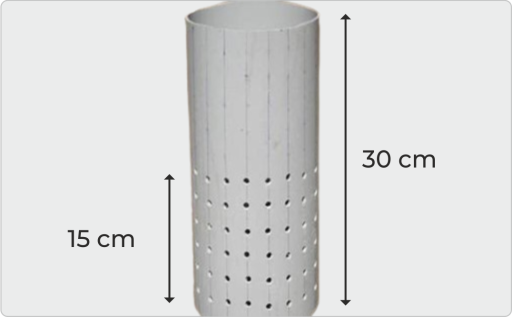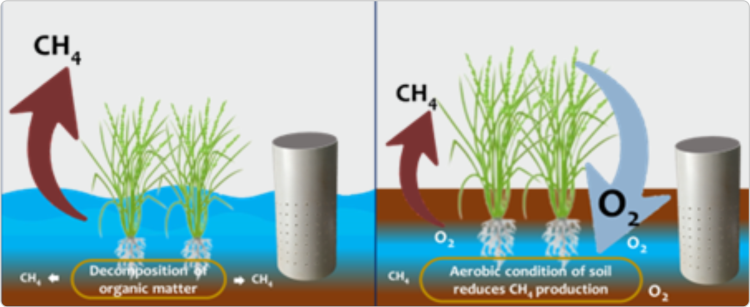About AWD
Alternate Wetting and Drying (AWD)
Alternate Wetting and Drying (AWD) is a water-saving technology that farmers can apply to reduce their irrigation water consumption in rice fields without decreasing yield. In AWD, irrigation water is applied a few days after the disappearance of the ponded water. Hence, the field gets alternately flooded and non-flooded GHG emissions are lower in AWD than with conventionally tilled transplanted puddle rice due to reduced anaerobic decomposition of organic matter in rice cropping soils and thus reduced generation of methane.

View of a sample AWD Pipe
In AWD the depth of ponded water in rice fields is monitored using a field water tube (Pani pipe). Field water tube is made up of 30 cm long PVC pipe having 15 cm diameter. The field water tube is perforated till 15 cm on all sides by drilling holes of 5mm diameter spaced 2 cm apart. The perforated side of the tube is to be buried in the soil and 15 cm of the pipe protrudes above the soil surface so that the water table is easily visible. The soil from inside the tube should be removed until the bottom of the tube is visible. The field water tube should be located in a well levelled representative spot of the field so as to ensuring that the water level maintained is similar both inside and outside the field water tube. This field water tube helps in assuring farmers, that water is available for the rice plant even when there is no visible standing water in the field. Proper weed management is important in all AWD conditions, as duration of no standing water in rice fields promote weed growth.
To implement AWD safely is by using a field water tube to monitor the water depth on the field. After irrigation, the water depth will gradually decrease. When the water level has dropped to the last perforated circle of the AWD pipe from downside which is around 13 cm below the surface of the soil, irrigation should be applied to re-flood the field to a depth of about 5-7 cm. From one week before to a week after flowering, the field should be kept flooded, topping up to a depth of 5-7 cm as needed. After flowering, during grain filling and ripening, the water level can be allowed to drop again till the last perforated circle of the AWD pipe which is around 13 cm below the soil surface before re-irrigation. AWD can be started a few weeks (1−2 weeks) after transplanting. When many weeds are present, AWD should be postponed for 2−3 weeks to assist suppression of the weeds by the ponded water and improve the efficacy of herbicide.
AWD leads to reductions in water consumption because they experience shorter inundation periods. The longer rice remains flooded, the more methane-producing Microbes grow, and the more methane they generate. Decreasing the duration of flooding therefore reduces methane production and emissions. Interrupting flooding even with occasional drawdowns has a dual effect: it quickly drives down the population of methane-producing Microbes, and it stimulates the breakdown of methane by bacteria.

Comparison of decomposition of organic matter in aerobic and anaerobic condition due to AWD
Benefits to the farmers:
- Substantial reduction in water usage and reduction of GHG emissions. Reduced flooding using AWD may improve soil structure for crops following rice due to increased soil aggregation and macroporosity. Effects on soil structure may be most apparent at lower depths from deeper root accumulation and improved aeration
- Cultivation cost reduction due to a reduced number of crop management operations (reduced number of irrigations under AWD). By reducing the number of irrigations, AWD can reduce water use by up to 30%. AWD does not reduce yields compared to continuous flooding and may, in fact, increase yields by promoting more effective tillering and stronger root growth of rice plants. However, compared to the scientific literature, the yield improvement on the actual farmers’ fields will be observed during the project implementation
- By reducing water use, sustainable farming practices can help extend the reach of irrigation systems, saving water in land preparation and during crop growth. This benefits farmers in areas with limited water resources, increases the coverage of more land with the same water, and contributes to climate change adaptation
Farmers are trained and motivated to adopt the recommended Alternate Wetting and Drying (AWD) technology, which will reduce CH4 emissions compared to the baseline scenario of continuous flooding. The only modification in the project scenario is the implementation of AWD in place of continuous flooding. All other existing agricultural practices remain unchanged, and no new activities are introduced that could lead to an increase in greenhouse gas emissions. However project farmers are trained to use nitrogen fertiliser responsibly thus reducing cost of cultivation and emission. Beneficiaries participating in the project have accepted its terms and grant the Project proponent full rights to the Verified Emission Reductions (VERs) resulting from the project.
TGRA and its implementation partners provide training, technical support, and on-season guidance for the farmers. Installation of AWD pipes, training on technical know-how, and demonstration of the adjusted water management practices are delivered to the farmers. A complete package of practices has been developed for the farmers with their benefit and environmental considerations in mind. Farmers are responsible for implementing adjusted water management practices in the paddy field, while FOs are responsible for recording day-to-day field-level Measurement, Reporting, and Verification (MRV) data points in the logbooks.
In addition to the training and support provided, the implementation partners regularly validate the data recorded by the farmers, not only to ensure data accuracy but also to identify gaps in the farmers’ training and address them accordingly.
through this project, the project proponent has provided advice on resource-efficient practices like Alternate wetting and drying method (AWD) with variations as per the region-specific requirements to mitigate CH4 emissions from the paddy fields in the project locations. These initiatives will lead to considerable reduction of CH4 emissions in the rice paddies and will contribute to the sustainable development of the rural societies.
